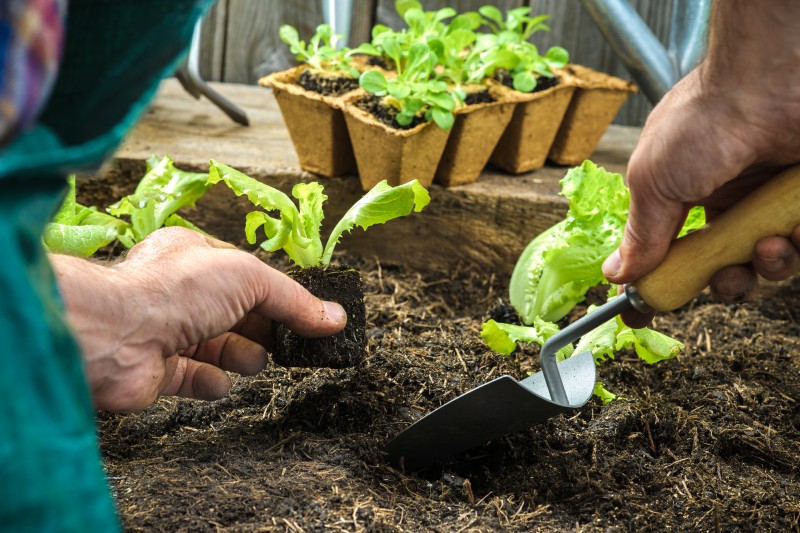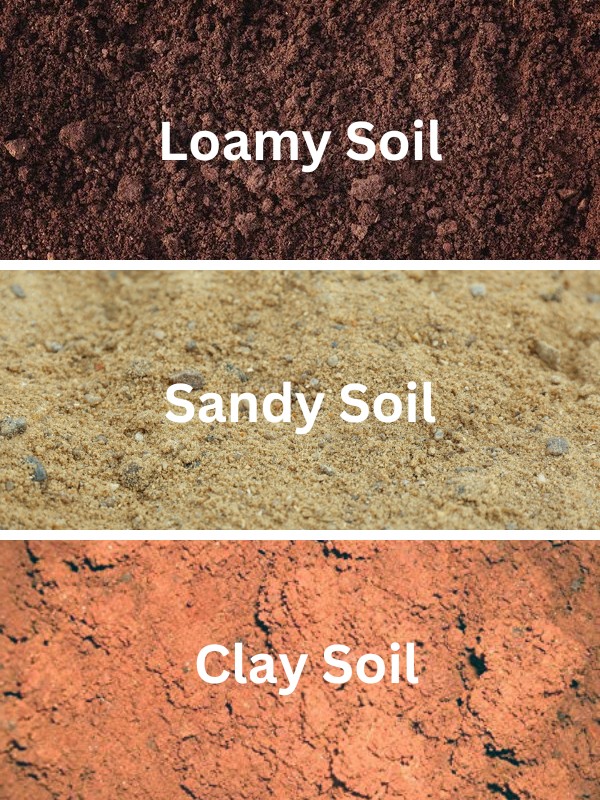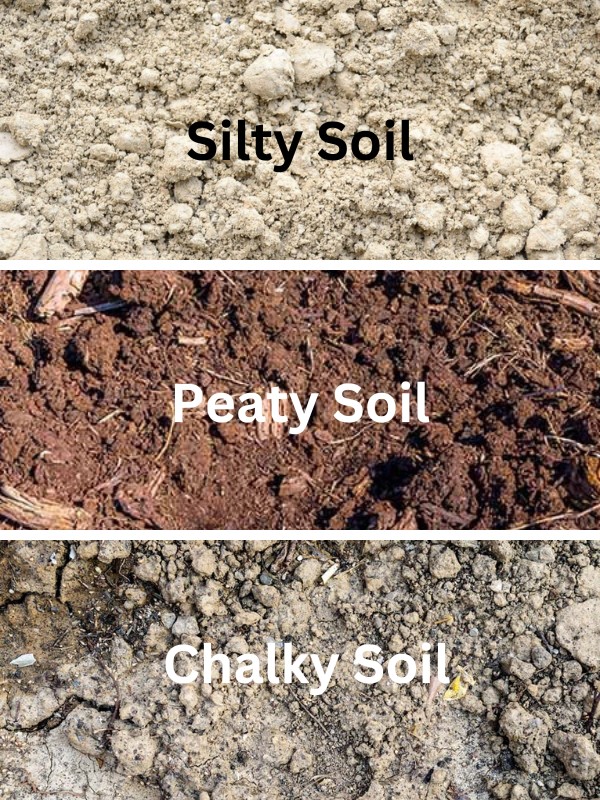You’re anticipating a great growing season with abundant blooms and yields! It helps to know the type of soil prevailing in your garden. This way, you can tailor its condition to the needs of the plants you wish to grow.

Lately, readers have asked how to identify their soil type. So, in this post, I discuss the different types of garden soil. You’ll discover their distinctive traits, such as texture, fertility, and drainage capacity. I also describe the jar soil test and the best plants for each soil category.
If your particular soil doesn’t suit your desired crops or flowers, you’ll learn how to amend it. So, let’s dig in!
Garden Soil Classifications
According to horticultural scientists, there are six types of garden soil:
- loamy
- sandy
- clay
- silty
- peaty
- chalky
Below are profiles for each soil category. See if you recognize yours among the descriptions.

1. LOAMY SOIL
Highly productive, loamy soil is dark brown and nutrient-rich. Loam is equal parts sand and silt (40% each), and 20% clay. Since loam warms up fast in springtime, you can start tilling your garden early.
Moreover, loamy soil excels at retaining moisture, a blessing you’ll appreciate in summer. In fact, when you hold a sample of loam, it feels slightly damp.
Since loamy soil has a crumbly texture, it drains well. At the same time, nutrients can wash through the soil at a moderate rate, needing replenishment.
How to Enhance Loamy Soil
During the growing season, add organic matter regularly, such as mulch and compost. Also helpful is crop rotation.
Plants That Love Loamy Soil
Vegetables that thrive in loam include lettuce, onions, tomatoes, green beans, peppers, and cucumbers. Also compatible are root crops, such as carrots. Among fruit plants, strawberries are right at home in loamy soil.
2. SANDY SOIL
This type of soil feels gritty and loose, making it easy to till and cultivate. Sandy soil consists of quartz crystals called silica.
The light brown granules are relatively large and spaced widely apart. As such, sandy soil drains quickly, making it nutrient-poor. It also dries out fast.
Hence, sandy ground needs amending for certain plants to thrive. Organic matter fills the gaps between sand particles, producing a dense, nutritious soil that holds moisture. For optimum viability, add organic matter from spring through fall.
How to Amend Sandy Soil
The best organic materials for sandy soil are compost, kelp meal, and manure. They impart nutrients to vegetation while balancing the acid pH of sand. You can aid moisture retention further by mulching your garden.
Plants That Prefer Sandy Soil
Herbs do nicely, such as lavender, rosemary, oregano, sage, and thyme. Tap-rooted vegetables welcome the ease of penetrating sandy soil. Examples are carrots, beets, parsnips, radishes, and turnips.
Potatoes enjoy the acidity of sandy soil, which curbs diseases such as scab. Other vegetables that revel in sandy soil are lettuce, peppers, collard greens, and tomatoes. Onions and garlic do well, too.
Do you have a rock garden? If so, sandy soil is ideal for cacti and succulents.
3. CLAY SOIL
Typically, clay soil is orange-red or reddish-brown with a heavy texture, warming up slowly with spring’s arrival. When saturated, clay soil is sticky, forming clumps. As it dries out, the ground turns rock-hard.
The compact nature of clay soil makes it tough for plant roots to grow. Meanwhile, clay doesn’t drain well, setting the stage for root rot. Plus, since clay particles bind to each other, plant roots can choke.
Even so, clay soil has some desirable traits. For one, it’s nutrient-rich. Clay particles are negatively charged, attracting soil minerals, such as magnesium, potassium, and calcium. In turn, clay soil feeds these nutrients to plants.
Secondly, clay holds moisture, advantageous in dry spells. So, if your soil has a moderate percentage of clay, your plants will handle drought better.
Tips for Upgrading Clay Soil
Clay soil desperately needs organic matter, such as manure, compost, or decayed leaves. First, add 4 inches of material to your topsoil. Then, mix it to a 6-inch depth using a tiller, garden fork, or shovel.
Doing this loosens clay soil, aerating it and promoting drainage. You can also improve the soil structure by adding greensand.
Plants Compatible with Clay Soil
Garden plants need strong roots to plow through clay soil. Champions include geraniums, asters, hostas, and ivy. Fruit trees can also manage clay soil.

4. SILTY SOIL
Silt is another granular substance, comprised of fine rock particles, midway in size between sand and clay. When silty soil is dry, it feels soft and floury. When saturated, it becomes slick like soap.
Silty soil is high in minerals owing to its rock origins, making it very fertile. However, it tends to get compacted and muddy, leading to root rot. Thus, silty soil needs augmenting to improve its texture and drainage.
How to Optimize Silty Soil
Mix organic matter with silty soil, such as compost, decayed leaves, and manure. First, apply a 3-inch layer to the topsoil. Then, using a tiller or shovel, work the material into the soil to an 8-inch depth, the average root zone of garden plants.
You can also raise the fertility of silty soil with nitrogen-fixing vegetables. Such plants attract bacteria that absorb nitrogen from the air, storing it in plant roots. Ideal nitrogen-fixing veggies are legumes, such as beans and peas.
Plants Favoring Silty Soil
Most fruit and vegetable plants flourish in silty soil, provided it has good drainage.
Still, this soil type is too compact for root vegetables. On the other hand, shallow-rooted plants are fine. Good candidates are broccoli, onions, garlic, and lettuce.
5. PEATY SOIL
This soil is dark brown to black, rich in partly decayed organic matter. While you’d think that peaty soil is a goldmine of nutrients, it falls short.
That’s because peat is acidic, hindering the breakdown of organic matter. Still, peaty soil warms up quickly in springtime.
Like a sponge, peaty soil absorbs and hangs onto water. Thus, it tends to have poor drainage. During summer, peaty soil can get bone dry, resisting water penetration. Then, when saturated, it feels springy.
How to Balance Peaty Soil
Mix peaty soil with compost and lime, taming its acidity. Also, dig drainage channels, spacing them strategically in your garden.
Plants That Enjoy Peaty Soil
Acid-loving vegetables do best in peaty soil, such as those in the Brassica family. Among its members are broccoli, cabbage, cauliflower, Brussels sprouts, and kale.
Shrubs that thrive in peaty soil are witch hazel, heather, rhododendron, azalea, and camellia.
6. CHALKY SOIL
Usually, chalky soil sits on limestone bedrock, making it shallow and alkaline. The pH of chalky soil ranges from 7.1 to 10, reflecting high levels of calcium carbonate. It also dries out fast. Moreover, chalky soil is grainier and stonier than other types of soil, draining freely.
Thus, chalky soil leaches nutrients, particularly magnesium and iron. Meanwhile, chalky soil speeds the breakdown of organic matter. Hence, it’s challenging to keep it fertile.
Most garden plants can’t tolerate chalky soil, becoming malnourished. Signs of nutritional deficits are leaf yellowing and stunted growth.
How to Rehabilitate Chalky Soil
Till in plenty of organic matter, such as manure, compost, and decayed pine needles. Next, sow legumes for their nitrogen-fixing magic.
Then, keep your plants well-mulched throughout the growing season, preventing moisture loss. To ward off nutrient deficiencies, fertilize regularly. Be sure to choose a plant food containing iron and magnesium.
Plants That Like Chalky Soil
Some vegetable plants do well in alkaline soil, such as beets, cabbage, spinach, and sweet corn. Shrubs favoring chalky soil are weigela, mock orange, and lilac.
How to identify your garden’s soil type?
One way to discern your type of soil is by rolling it into a ball and noting its texture. Your soil will respond in a certain way, revealing its primary composition.
So, take a thimble-sized mass of soil and roll it between your first three fingers. Try to form a ball with it. Then, compare your result with the descriptions below.
- Soil is crumbly and forms a ball easily, yet doesn’t hold its shape = loamy soil.
- Earth feels gritty and falls apart = sandy soil.
- Your sample feels sticky, looks shiny, and forms a ball, staying intact = clay soil.
- Soil feels slippery, but it does roll into a ball = silty soil.
- You can squeeze the soil into a ball, and it feels spongy = peaty soil.
- Soil has small stones and takes work to form a ball = chalky soil. For confirmation, place your sample in a jar of vinegar. Chalky soil will froth, indicating a high level of calcium carbonate.
NOTE – While most soils have a predominant type, they can also be a mixture.
What is the jar test for soil type?
This assessment reveals the percentages of each kind of soil in your garden plot. Here’s how to do the jar test.
- Dig into your garden about 6 inches deep. Scoop two handfuls of soil into a large food storage bag.
- Spread your soil sample on newspaper, allowing it to air-dry. Then, sift the soil with your fingers, removing any rocks, leaves, bark, and other plant debris.
- Fill a large glass jar one-third full with the soil, adding water to an inch below the rim. Then, add a smidgen of laundry detergent or a pinch of salt, helping the components to separate.
- With the jar lidded, shake it well. Then, set it aside for several days, allowing time for the soil components to settle. Gradually, distinct layers will form.
- First, sand will head for the bottom of the jar, followed by silt and clay. When the clay settles fully, the water will look almost clear.
Now you can see which type of soil prevails in your garden.
Should I get a soil test?
Get a soil test if your garden plants have done poorly in the past for unknown reasons. Testing the soil will reveal its pH and primary nutrient levels.
Did you recently move to a new area? If so, it’s a good idea to assess the health of your garden soil. If you add amendments, testing the soil will show changes in its fertility.
Most garden plants fare best with a slightly acidic soil pH, between 6.0 and 6.5. This range enables plant roots to access nutrients.
Meanwhile, desirable soil organisms can flourish, such as earthworms. However, a higher pH can lock up minerals, and a lower pH can be toxic to many plant species.
A soil test can save you money on inappropriate or unnecessary fertilizers. Moreover, soil tests are inexpensive, whether you buy a kit from a garden center or send a soil sample to a lab. You can test the soil anytime it’s not frozen.
Is it best to have my soil lab-tested?
It’s preferable since labs perform comprehensive soil assessments. State universities run Cooperative Extension Services (CES), affiliated with certain soil testing laboratories. Some CES programs operate from post offices, courthouses, and other government buildings.
A designated lab will do a thorough chemical assay of your soil using high-tech equipment. Next, the lab relays its findings to its partner Cooperative Extension Office.
Then, the Office sends you a report by mail or email. It will explain the analysis and recommend fertilizers or lime based on what you want to grow.
Moreover, if the lab found lead in your soil, the CES will tell you if the level is potentially hazardous. This is possible if you live near a factory, landfill, or older homes where the siding has lead paint. The report also includes a staff contact person and phone number who can answer any questions you have.
Call your local Cooperative Extension Office for where to send your soil sample. Here’s a search tool for an Extension Office near you.
How do you collect a soil sample for a lab?
You’ll need a garden spade, shovel, auger, or soil probe. Then, follow these steps.
- Dig a hole to a 6-inch depth. Take a slice of earth and trim the sides, creating a 1-inch column of soil.
- Obtain nine more samples from various spots in your garden, totaling one pint of soil. Mix the samples in a clean plastic bucket. Then, remove any rocks, plant parts, or other debris.
- The composite sample must be dry. If you can squeeze water from the soil, spread it on newspaper, letting it dry at room temperature. Then, transfer the soil to a zipper-sealed plastic bag, attaching a label showing your name and address.
- Visit the website of your local Cooperative Extension Office to download its submission form. When completing it, include the plants you wish to grow. Also, note the fee for the testing service.
- Place your soil sample, submission form, and payment in a padded envelope or a small box.
- Mail or bring your soil sample to the Cooperative Extension Office.
What kind of soil is best for growing plants?
The ideal soil for growing vegetables and flowers is loam, having a balanced mix of silt, sand, and clay. Meanwhile, loam contains decomposed plant matter called humus, rich in the nutrients plants need to thrive.
Additionally, loamy soil retains water and drains well. Its crumbly texture promotes airflow, enabling plant roots to breathe. Generally, loamy soil has the optimal pH for most plants, ranging from 6.0 to 6.5.
If your soil isn’t loamy, you can use organic matter and amendments to make it loam-like. Ideally, do this in autumn, allowing the materials to decompose somewhat before spring.
Another option is growing plants befitting your soil type. Still, get your soil tested first, revealing its nutrient profile, pH, and whether it contains lead.
Lush Garden
You can gauge your soil type in two ways. One is by feeling its texture and rolling a marble-sized amount into a ball. Or, use the jar test, mixing a soil sample with water in a jar and observing how the components settle.
With either method, you’ll learn the kind of soil predominating in your plot. Here’s a recap of the six types of garden soil.
- Loamy – crumbly, teems with nutrients, holds moisture, and drains well.
- Sandy – loose and gritty, root-friendly, yet drains too fast, leaching nutrients.
- Clay – dense and heavy, nutrient-packed, and retains water but needs loosening.
- Silty – soft, floury, and compact when dry, muddy when saturated, and nutrient-rich.
- Peaty – spongy and acidic, draining poorly when saturated, then resisting water upon drying out.
- Chalky – grainy, stony, and alkaline, draining and drying fast, losing nutrients.
All the above soils benefit by adding organic matter, such as mulch, compost, decayed leaves, and manure. For sandy soil, mix in kelp meal, and for clay soil, incorporate greensand.
You can boost the fertility of silty and chalky soils by planting nitrogen-fixing legumes. Since peaty soil is acidic, use lime to balance its pH.
To know your soil’s pH and nutrient level, send a sample to a lab affiliated with your local Cooperative Extension Office.
Have fun discerning your soil type and optimizing its structure. May your growing season be fantastic!
Related Posts
- Landscaping with Rocks vs Mulch with Pros and Cons
- How to Create a Low Maintenance Garden
- 5 Benefits of Having Artificial Grass for Your Pets to Play On
- 12 Main Pros and Cons of a Pea Gravel Patio for Your Home
- Want to Redo Your Lawn? Here Are Your Options
- How to Fix and Dry a Muddy Yard – Here Are Several Effective Ways
Leave a Reply